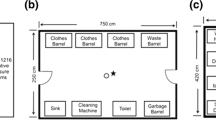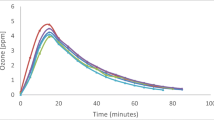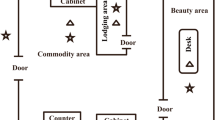Abstract
As with all indoor public spaces in Taiwan, the stack rooms in public libraries should meet the air quality guidelines laid down by the Taiwan Environmental Protection Administration. Accordingly, utilizing a university library in Taiwan for experimental purposes, this study investigates the efficiency of gaseous chlorine dioxide (ClO2) as a disinfection agent when applied using three different treatment modes, namely a single-daily disinfection mode (SIM), a twice-daily disinfection mode (TWM), and a triple-daily disinfection mode (TRM). For each treatment mode, the ClO2 is applied using an ultrasonic aerosol device and is performed both under natural lighting conditions and under artificial lighting conditions. The indoor air quality is evaluated before and after each treatment session by measuring the bioaerosol levels of bacteria and fungi. The results show that for all three disinfection modes, the application of ClO2 reduces the indoor bacteria and fungi concentrations to levels lower than those specified by the Taiwan EPA (i.e., bacteria <1500 CFU/m3, fungi <1000 CFU/m3), irrespective of the lighting conditions under which the disinfection process is performed. For each disinfection mode, a better disinfection efficiency is obtained under natural lighting conditions since ClO2 readily decomposes under strong luminance levels. Among the three treatment modes, the disinfection efficiencies of the TWM and TRM modes are very similar under natural lighting conditions and are significantly better than that of the SIM mode. Thus, overall, the results suggest that the TWM treatment protocol represents the most cost-effective and efficient method for meeting the indoor air quality requirements of the Taiwan EPA.



Similar content being viewed by others
References
ACGIH. (1989). Guidelines for assessment of bioaerosols in the indoor environment. American Conference of Governmental Industrial Hygienists: Cincinnati, Ohio.
Adhikari, A., Sen, M. M., Gupta-Bhattacharya, S., & Chanda, S. (2004). Volumetric assessment of airborne fungi in two sections of a rural indoor dairy cattle shed. Environment International, 29, 1071–1078.
AIHA. (1996). Field guide for the determination of biological contaminants in environmental samples. Fairfax, Va.: AIHA Press.
Apetrei, I. C., Drăgănescu, G. E., Popescu, I. T., Carp-Cărare, C., Guguianu, E., Mihăescu, T., Ştefanache, A., Creţu, C., & Patraş, X. (2009). Possible cause of allergy for the librarians: books manipulation and ventilation as sources of fungus spores spreading. Aerobiologia, 25(3), 159–166.
Burge, P. S. (2004). Sick building syndrome. Occupational and Environmental Medicine, 61, 185–190.
Buttner, M. P., Cruz-Perez, P., & Stetzenbach, L. D. (2001). Enhanced detection of surface-associated bacteria in indoor environments by quantitative PCR. Applied and Environmental Microbiology, 67, 2564–2570.
Buttner, M. P., Cruz, P., Stetzenbach, L. D., Klima-Comba, A. K., Stevens, V. L., & Cronin, T. D. (2004). Determination of the efficacy of two building decontamination strategies by surface sampling with culture and quantitative PCR analysis. Applied and Environment Microbiology, 70, 4740–4747.
Canter, D. A., Gunning, D., Rodgers, P., O’Connor, L., Traunero, C., & Kempter, C. J. (2005). Remediation of Bacillus anthracis contamination in the U.S. Department of Justice mail facility. Biosecurity and Bioterrorism, 3, 119–127.
Chen, Y. S., & Vaughn, J. M. (1990). Inactivation of human and simian rotaviruses by chlorine dioxide. Applied and Environmental Microbiology, 56, 1363–1366.
Cortezzo, D. E., Koziol-Dube, K., Setlow, B., & Setlow, P. (2004). Treatment with oxidizing agents damages the inner membrane of spores of Bacillus subtilis and sensitizes spores to subsequent stress. Applied and Environmental Microbiology, 97, 838–852.
Council European Community. (1993). Biological particles in indoor environments. European Collaborative Action, Luxembourg: Council European Community.
Douwes, J., Thorne, P., Pearce, N., & Heederik, D. (2003). Bioaerosol health effects and exposure assessment: progress and prospects. Annals of Occupational Hygiene, 47, 187–200.
Han, Y., Applegate, B., Linton, R. H., & Nelson, P. E. (2003). Decontamination of Bacillus thuringiensis spores on selected surfaces by chlorine dioxide gas. Journal Environmental Health, 66, 16–21.
Jaakkola, M. S., Yang, L., Ieromnimon, A., & Jaakkola, J. J. K. (2007). Office work exposures and respiratory and sick building syndrome symptoms. Occupational and Environmental Medicine, 64(3), 178–184.
Lee, S. Y., Dancer, G. I., Chang, S. S., Rhee, M. S., & Kang, D. H. (2006). Efficacy of chlorine dioxide gas against Alicyclobacillus acidoterrestris spores on apple surfaces. International Journal of Food Microbiology, 108, 364–368.
Li, C. S., & Kuo, Y. M. (1992). Airborne characterization of fungi indoors and outdoors. Journal of Aerosol Science, 23(1), 667–670.
Lin, K. S., Hsieh, M. J., Liou, M. J., Lee, S. L., & Lai, C. K. (2007). Disinfection effect of chlorine dioxide on air quality control in Armed Forces General Hospital of Taiwan. Nature and Science, 5(4), 94–99.
Loret, J. F., Robert, S., Thomas, V., Cooper, A. J., McCoy, W. F., & Levi, Y. (2005). Comparison of disinfectants for biofilm, protozoa and Legionella control. Journal of Water and Health, 3, 423–433.
Mendell, M. J., Lei-Gomez, Q., Mirer, A. G., Seppänen, O., & Brunner, G. (2008). Risk factors in heating, ventilating, and air-conditioning systems for occupant symptoms in US office buildings: the US EPA BASE study. Indoor Air, 18, 301–316.
Nayak, B. K., & Nanda, A. (2011). Comparative incidence and seasonality of airborne fungi in a library environment with meteorological effect. Indian Journal of Aerobiology, 24(2), 70–76.
Obvintseva, L. A., & Gubanova, D. P. (2004). Rapid detection of chlorine and chlorine dioxide in air using semiconductor sensors. Journal of Analytical Chemistry, 59(8), 785–787.
Orsini, M., Laurenti, P., Boninti, F., Arzani, D., & Ianni, A. (2002). A molecular typing approach for evaluating bioaerosol exposure in wastewater treatment plant workers. Water Research, 36, 1375–1378.
Rakotonirainy, M. S., Fohrer, F., & Flieder, F. (1999). Research on fungicides for aerial disinfection by thermal fogging in libraries and archives. International Biodeterioration & Biodegradation, 44(2–3), 133–139.
Sivaganesan, M., Rice, E. W., & Marinas, B. J. (2003). A Bayesian method of estimating kinetic parameters for the inactivation of Cryptosporidium parvum oocysts with chlorine dioxide and ozone. Water Research, 37, 4533–4543.
Southwell, K. L. (2002). The use of chlorine dioxide as a mold treatment and its effect on paper acidity: a case study. The Journal of Academic Librarianship, 28, 400–405.
Stetzenbach, L. D. (2007). Manual of environmental microbiology. Washington D.C: ASM Press.
Strzelczyk, A. B. (2004). Observations on aesthetic and structural changes induced in Polish historic objects by microorganisms. International Biodeterioration & Biodegradation, 53(3), 151–156.
Taiwan EPA. (2008). Guidelines on environmental analysis laboratory EPA, Taiwan Environmental Protection Administration. http://www.niea.gov.tw/analysis/method/ListMethod.asp?methodtype=LIVE. Accessed 5 Dec 2012.
Taiwan EPA. (2012). Guidelines on indoor air quality, Taiwan Environmental Protection Administration. http://www.indoorair.org.tw/. Accessed 5 Dec 2012.
Tasi, Y. M., & Liu, H. M. (2009). Exposure to culturable airborne bioaerosols during noodle manufacturing in central Taiwan. Science of the Total Environment, 407, 1536–1546.
Taylor, G. R., & Butler, M. (1982). A comparison of the virucidal properties of chlorine, chlorine dioxide, bromine chloride and iodine. The Journal of Hygiene (Lond), 89, 321–328.
U.S. EPA. (2000). Toxicological review of chlorine dioxide and chlorite (p. 6). Washington: United States Environmental Protection Agency; CAS Nos. 10049-04-4 and 7758-19-2.
U.S. EPA. (2006). Technical evaluation report on evaluation of chlorine dioxide gas generator. Washington, DC.: United States Environmental Protection Agency; EPA 600-R-06.
U.S. EPA. (2007). Pesticides: topical & chemical fact sheets-chlorine dioxide. Washington, DC: US Environmental Protection Agency.
US Department of Labor, Occupational Safety and Health Administration, (2006). Occupational safety and health guideline for chlorine dioxide. http://www.osha.gov/SLTC/healthguidelines/chlorinedioxide/recognetion.html. Accessed 12 Apr 2014.
Vogt, H., Balej, J., Bennett, J. E., Wintzer, P., Sheikh, S. A., Gallone, P., Vasudevan, S., & Pelin, K. (2011). Chlorine Oxides and Chlorine Oxygen Acids. In Wiley-VCH (Ed.), Ullmann's Encyclopedia of Industrial Chemistry (7th ed.). New York: Wiley-VCH.
Weaver-Meyers, P. L., Stolt, W. A., & Kowaleski, B. (1998). Controlling mold on library materials with chlorine dioxide: an eight-year case study. Journal of Academic Librarianship, 24, 455–458.
WHO. (2002). Guidelines for concentration and exposure–response measurements of fine and ultra fine particulate matter for use in epidemiological studies. Geneva: World Health Organization.
Young, S. B., & Setlow, P. (2003). Mechanisms of killing of Bacillus subtilis spores by hypochlorite and chlorine dioxide. Journal Applied Microbiology, 95, 54–67.
Author information
Authors and Affiliations
Corresponding author
Rights and permissions
About this article
Cite this article
Hsu, CS., Lu, MC. & Huang, DJ. Disinfection of indoor air microorganisms in stack room of university library using gaseous chlorine dioxide. Environ Monit Assess 187, 17 (2015). https://doi.org/10.1007/s10661-014-4235-2
Received:
Accepted:
Published:
DOI: https://doi.org/10.1007/s10661-014-4235-2




